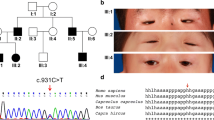Abstract
The blepharophimosis syndrome (BPES) is an autosomal dominant developmental disorder in which craniofacial/eyelid malformations are associated (type I) or not (type II) with premature ovarian failure (POF). Mutations in the FOXL2 gene, encoding a forkhead transcription factor, are responsible for both types of BPES. Heterozygous polyalanine expansions of +10 residues (FOXL2–Ala24) account for 30% of FOXL2 mutations and are fully penetrant for the eyelid phenotype. Here we describe the first homozygous FOXL2 mutation leading to a polyalanine expansion of +5 residues (FOXL2–Ala19). This novel mutation segregates in an Indian family where heterozygous mutation carriers are unaffected whereas homozygous individuals have the typical BPES phenotype, with proven POF in one female. Expression of the FOXL2–Ala19 protein in COS-7 cells revealed a significantly higher cytoplasmic retention compared to the wild-type protein. This is the first study providing genetic evidence for a recessive inheritance of BPES associated with ovarian dysfunction.


Similar content being viewed by others
References
Akarsu AN, Stoilov I, Yilmaz E, Sayli BS, Sarfarazi M (1996) Genomic structure of HOXD13 gene: a nine polyalanine duplication causes synpolydactyly in two unrelated families. Hum Mol Genet 5:945–952
Albrecht A, Mundlos S (2005) The other trinucleotide repeat: polyalanine expansion disorders. Curr Opin Genet Dev 15:285–293
Albrecht AN, Kornak U, Boddrich A, Suring K, Robinson PN, Stiege AC, Lurz R, Stricker S, Wanker EE, Mundlos S (2004) A molecular pathogenesis for transcription factor associated poly-alanine tract expansions. Hum Mol Genet 13:2351–2359
Bachetti T, Matera I, Borghini S, Di Duca M, Ravazzolo R, Ceccherini I (2005) Distinct pathogenetic mechanisms for PHOX2B associated polyalanine expansions and frameshift mutations in congenital central hypoventilation syndrome. Hum Mol Genet 14:1815–1824
Beysen D, Raes J, Leroy BP, Lucassen A, Yates JR, Clayton-Smith J, Ilyina H, Brooks SS, Christin-Maitre S, Fellous M, Fryns JP, Kim JR, Lapunzina P, Lemyre E, Meire F, Messiaen LM, Oley C, Splitt M, Thomson J, Peer YV, Veitia RA, De Paepe A, De Baere E (2005) Deletions involving long-range conserved nongenic sequences upstream and downstream of FOXL2 as a novel disease-causing mechanism in blepharophimosis syndrome. Am J Hum Genet 77:205–218
Caburet S, Demarez A, Moumne L, Fellous M, De Baere E, Veitia RA (2004) A recurrent polyalanine expansion in the transcription factor FOXL2 induces extensive nuclear and cytoplasmic protein aggregation. J Med Genet 41:932–936
Cocquet J, De Baere E, Gareil M, Pannetier M, Xia X, Fellous M, Veitia RA (2003) Structure, evolution and expression of the FOXL2 transcription unit. Cytogenet Genome Res 101:206–211
Cocquet J, Pailhoux E, Jaubert F, Servel N, Xia X, Pannetier M, De Baere E, Messiaen L, Cotinot C, Fellous M, Veitia RA (2002) Evolution and expression of FOXL2. J Med Genet 39:916–921
Crisponi L, Deiana M, Loi A, Chiappe F, Uda M, Amati P, Bisceglia L, Zelante L, Nagaraja R, Porcu S, Ristaldi MS, Marzella R, Rocchi M, Nicolino M, Lienhardt-Roussie A, Nivelon A, Verloes A, Schlessinger D, Gasparini P, Bonneau D, Cao A, Pilia G (2001) The putative forkhead transcription factor FOXL2 is mutated in blepharophimosis/ptosis/epicanthus inversus syndrome. Nat Genet 27:159–166
De Baere E, Beysen D, Oley C, Lorenz B, Cocquet J, De Sutter P, Devriendt K, Dixon M, Fellous M, Fryns JP, Garza A, Jonsrud C, Koivisto PA, Krause A, Leroy BP, Meire F, Plomp A, Van Maldergem L, De Paepe A, Veitia R, Messiaen L (2003) FOXL2 and BPES: mutational hotspots, phenotypic variability, and revision of the genotype–phenotype correlation. Am J Hum Genet 72:478–487
De Baere E, Dixon MJ, Small KW, Jabs EW, Leroy BP, Devriendt K, Gillerot Y et al (2001) Spectrum of FOXL2 gene mutations in blepharophimosis-ptosis-epicanthus inversus (BPES) families demonstrates a genotype–phenotype correlation. Hum Mol Genet 10:1591–1600
Goodman FR, Mundlos S, Muragaki Y, Donnai D, Giovannucci-Uzielli ML, Lapi E, Majewski F, McGaughran J, McKeown C, Reardon W, Upton J, Winter RM, Olsen BR, Scambler PJ (1997) Synpolydactyly phenotypes correlate with size of expansions in HOXD13 polyalanine tract. Proc Natl Acad Sci USA 94:7458–7463
Horsnell K, Ali M, Malik S, Wilson L, Hall C, Debeer P, Crow Y (2006) Clinical phenotype associated with homozygosity for a HOXD13 7-residue polyalanine tract expansion. Eur J Med Genet. DOI 10.1016/j.ejmg.2006.01.004
Miller SA, Dykes DD, Polesky HF (1988) A simple salting out procedure for extracting DNA from human nucleated cells. Nucleic Acids Res 16:1215
Muragaki Y, Mundlos S, Upton J, Olsen BR (1996) Altered growth and branching patterns in synpolydactyly caused by mutations in HOXD13. Science 272:548–551
Trochet D, Hong SJ, Lim JK, Brunet JF, Munnich A, Kim KS, Lyonnet S, Goridis C, Amiel J (2005) Molecular consequences of PHOX2B missense, frameshift and alanine expansion mutations leading to autonomic dysfunction. Hum Mol Genet 14:3697–3708
Zlotogora J, Sagi M, Cohen T (1983) The blepharophimosis, ptosis, and epicanthus inversus syndrome: delineation of two types. Am J Hum Genet 35:1020–1027
Acknowledgments
RAV is supported by the INSERM and the University Paris VII. PS is supported by the Aravind Medical Research Foundation, Aravind Eye Hospital, Madurai, Tamilnadu, India. EDB is supported by the Fund for Scientific Research (FWO) (post-doctoral fellowship; KAN N° 1.5.244.05; mobility grant 1M84304N). DB is supported by Bijzonder Onderzoeksfonds of the Ghent University (BOZF N° BOF2002/DRMAN/047). JN has been supported by a Sandwich Fellowship from the French Embassy in India. We thank the patients involved in this study for their cooperation and two anonymous reviewers for their helpful and constructive criticisms.
Author information
Authors and Affiliations
Corresponding author
Additional information
Periasamy Sundaresan and Reiner A. Veitia contributed equally to the development of this work and are listed alphabetically.
Rights and permissions
About this article
Cite this article
Nallathambi, J., Moumné, L., De Baere, E. et al. A novel polyalanine expansion in FOXL2: the first evidence for a recessive form of the blepharophimosis syndrome (BPES) associated with ovarian dysfunction. Hum Genet 121, 107–112 (2007). https://doi.org/10.1007/s00439-006-0276-0
Received:
Accepted:
Published:
Issue Date:
DOI: https://doi.org/10.1007/s00439-006-0276-0




